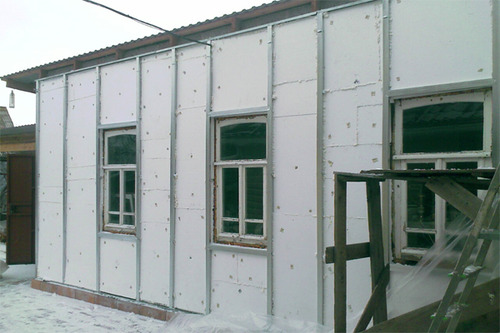
Photo: izol.su
Polystyrene plates are effective as insulation, as they have a low coefficient of thermal conductivity. The low weight of the plates simplifies installation, and it doesn’t make the wall itself too heavy. This material is easily processed, while extruded is more elastic, so that it is more convenient to work with it. Expanded polystyrene has good strength characteristics in compression and tear. The extruded mechanical strength is much greater than that of conventional foam, although it is somewhat limited. Durability is measured in tens of years (the guarantee is given for periods of the order of 50 years), but additional external finishing is required.
The material is not hygroscopic, so that the thermal insulation does not deteriorate even when moisture gets on the plate. Resistance to water gives it a hydro-barrier properties without the need for additional waterproofing. However, the ends should be protected from moisture near the openings, as if the insulating layer penetrates inside, excessive moisture can swell or peel off the material. The material is resistant to light, is not afraid of frost and heat, is not subject to the influence of daily temperature differences. Quality material is self-extinguishing and does not sustain combustion, but the fire still destroys it.
There are foam polystyrene and disadvantages. So it does not have good sound insulation. The vapor permeability coefficient is also low. Although some degree of vapor permeability is present, the room may become excessively wet, windows may mist over, and therefore more frequent airing is required. Heating above 80 ° C may cause partial destruction. Material is not resistant to many organic solvents. Compared with mineral wool, polystyrene foam has better thermal performance and moisture resistance. For the facade insulation we need slabs of mineral wool, which are more expensive than expanded polystyrene, although simple mineral wool is more affordable. But mineral wool is not afraid of mice, which is not the case with expanded polystyrene.
If you choose a material of this type, you should give preference to extruded polystyrene foam, which has better performance compared to conventional foamed polystyrene (conventional foam) and other foamed polymers. These materials are not expensive, while extruded polystyrene is more expensive than foamed, but also more efficient and safer. In terms of its application, polystyrene foam is good for outdoor insulation of houses, mainly residential buildings up to 25 m tall and private houses. For public buildings use it is not accepted. The use of this material in ventilated facades with a coating of industrial elements, as well as translucent finishes are violations of safety requirements. Exterior finishing with plaster or brick is necessary not only for aesthetic purposes, but also for additional protection and extension of service life.
This type of insulation is very effective in the selection of high-quality materials and compliance with installation technology. What is important is not only high-quality polystyrene foam, but also good adhesives, fasteners and reinforcing elements.
